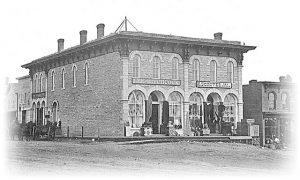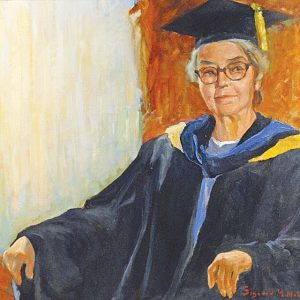The year 2016 marks the 125th anniversary of St. Olaf College’s first music organization, a group once led by F. Melius Christiansen. No, it is not the world-renowned St. Olaf Choir. It is the St. Olaf Band. The band, led by conductor Timothy Mahr, will be capping its national winter tour with a concert at New York City’s famed Carnegie Hall on Feb. 6, followed by a home concert Feb. 13. There will be an alumni band gathering and concert June 4 during reunion weekend. (See interview with Mahr below.)

St. Olaf’s School, founded in 1874 in Northfield by Norwegian immigrants as a coeducational liberal arts school, offered instruction in piano, organ and voice from its inception. Early catalogs show instruction in both vocal and instrumental music. Student Engebret Lee obtained some discarded instruments in town in 1890 and, in October of 1891, the Manitou Messenger school newspaper wrote: “The students here have organized a brass band, styled the St. Olaf College Cornet Band. The band has 14 members, who practice four times a week. This band should have been started long ago; and now that it is started, all should give it their hearty support.” A teacher, John Dahle, led the all-male band which accompanied hymns for commencement exercises that spring. A succession of student directors followed.
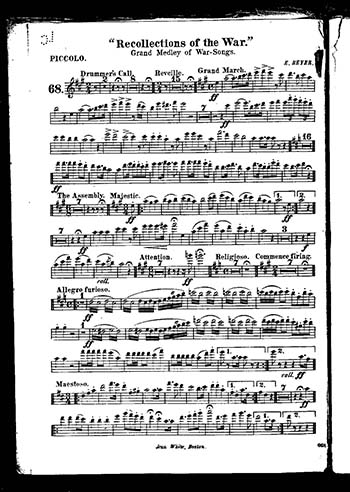
A commencement concert was shared with the community on June 17, 1893, at the Northfield City Park, conducted by Adolph Larson of the graduating class. Among the pieces played were Down on the Farm and The Old Church Organ, plus a grand medley of Civil War songs (which featured a drummer’s call, various bugle calls and the instructions “commence firing” in the score). The program concluded with Southwell’s march, Westwood. The Northfield News of June 24 wrote, “As this was the first annual concert which the band has given, it was looked forward to with a great deal of expectancy by both the students and citizens. The evening was clear and beautiful and a large audience was scattered about the park at an early hour” with “a number of vehicles” stretched along in the streets. The program was “rendered in a manner which conferred great credit on the leader, Mr. A. Larson.”
In 1894, the band started a tradition by climbing to the tower of Old Main to celebrate Syttende Mai, Norway’s Constitution Day, on May 17. The Manitou Messenger reported that the band flooded the city with “sweet music, which brought the people to their feet earlier than usual.” (Yes, indeed. The band played between four and six a.m.) The next month, the paper noted that the band “now owns a complete set of band instruments,” a slide trombone, piccolo, six cornets, various horns and a snare and bass drum. (The story also mentioned the college’s “highly creditable” orchestra, which included two female violinists. It was not until 1921 that the St. Olaf Band had female members: Klara Overby and Clara Duea. Duea, Class of 1923, became a professor of piano and organ at Concordia College in Moorhead, establishing that college’s music club and Christmas Festival tradition. Northfield’s other college, Carleton, added a female cellist and harpist to its concert band under its well-respected conductor Jimmy Gillette in 1929.)
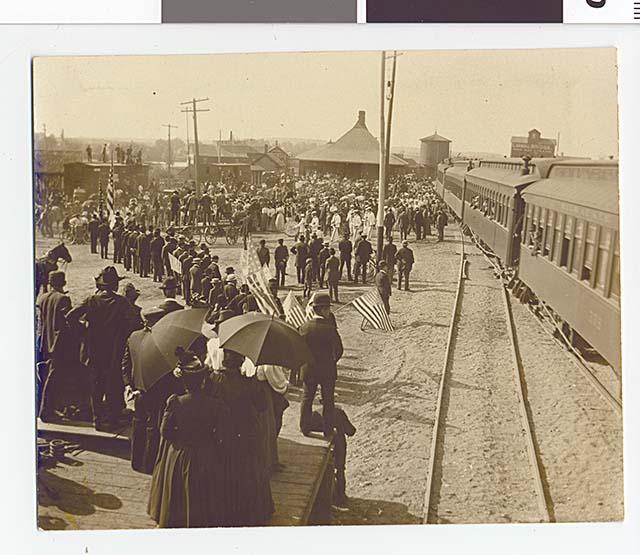
The St. Olaf Band was embraced by Northfield and took part in historic events. The Northfield News of March 27, 1897, reported: “Last Monday evening the new telephone company gave its patrons quite a musical treat by telephone. St. Olaf college band was stationed in the central office and the switch was thrown open so that the 40 ‘phones now in operation could be used to carry the sweet notes to all parts of the city. Several selections were played by the band and the music could be very distinctly heard through any of the ‘phones.” The newspaper exulted, “The new telephone system works to perfection and we wish the company success.”
“Music must be had,” said the Northfield News, recounting how citizens rushed to search for the St. Olaf Band when 30 men, including students from St. Olaf and Carleton, were about to depart by train for Faribault on Sunday, April 24, 1898, to enlist with the National Guard for the Spanish-American War. Seventeen band members, resplendent in new uniforms, played at the station and escorted the recruits to Faribault. Later that week the band played at an Odd Fellows banquet and at Mayor Skinner’s house at receptions for the recruits. On April 29, a special train bearing recruits from Fairmont, Spring Valley, Austin and Faribault arrived at Northfield’s Milwaukee depot as a crowd of around 2,000 gathered to support their enlistees. The band, which had led a St. Olaf contingent from campus, “played their loudest” as the train pulled out at 8:37 a.m. amid cheers and flag-waving.

A measure of the local affection for the “Boys in White” (so-named for their distinctive white, military-style uniforms) is found in the Northfield News of Feb. 25, 1899, after a concert at the Congregational church. The story said the 24-piece band showed its “highest degree of perfection since organization” and concluded, “It is not only with the excellent music that the citizens of Northfield are so partial, but the manliness, the uprightness and the good manners of the entire personnel of the organization commends the boys to favor. Northfield has many things to be proud of and foremost among these is the St. Olaf college band.”
Andrew Onstad had conducted the band as a senior during the 1898-99 school year and was engaged as the first paid director of the band in December of 1899. A fine clarinet player, Onstad added woodwind instruments to make it a concert band. Georgina Dieson Hegland, in her book As it Was in the Beginning (1950), described him as “a person of natural musical ability, quick, and fiery!”
St. Olaf College Associate Archivist Jeff Sauve related to me an anecdote about the 1902 band: “A Northfield seamstress, Mrs. Dora Kump, accidentally pricked a finger on a rusty pin while mending one of the well-worn original white uniforms of the St. Olaf Band. Kump, a mother of eight, suffered ‘blood poisoning’ that necessitated amputation of her right hand. The Band students, distraught over her situation, offered a benefit concert in town. The event raised nearly $75 for her family — a considerable sum that was equal to two months of steady work at that time. The Northfield News noted, ‘The band boys have again shown the kind of metal they are made of and as usual did the right thing at the right time.’ She died soon afterwards from blood poisoning.”

After John Nathan Kildahl became President of St. Olaf College in 1899, he urged the United Norwegian Lutheran Church which supported the college to establish a music department and was successful in his third try in 1903. Paul G. Schmidt, an 1891 St. Olaf academy graduate who had been hired as a mathematics professor at St. Olaf in 1902, suggested that F. Melius Christiansen be hired as the first director of the new music department. Schmidt, who had sung in the Kjerulf Male Chorus in Minneapolis which Christiansen directed, wrote in My Years at St. Olaf, that Christiansen’s “passionate striving for perfection in his interpretations and presentations gave me a new insight into the power of song.” Christiansen was hired to head the department, conduct the band and chorus and teach violin and music theory for $600 a year.

Christiansen dedicated himself first to improving the band. Schmidt recalled that Christiansen “demanded and enforced strict discipline and attention. He was not at all impressed by the fact the band could play some marches from beginning to end without any noticeable mishap, but made every effort to improve tone quality and balance in the different sections, spent a great deal of time in repetition of certain musical phrases, and – what really surprised some of them – took time to show them how to handle and finger their instruments most effectively.”
Christiansen played violin at the first faculty recital of the new music department on Sept. 23, 1903, a benefit to get a new oboe for the band. On Oct. 11, he led the band as it played music for the dedication of Waldorf College in Forest City, Iowa. The Northfield News said, “Mr. Christiansen wields an almost magnetic baton” after a Nov. 18 concert in town. The Manitou Messenger wrote approvingly that month, “He is the man for the place. As a result of the new order of things interest for the art melodious has taken an upward shoot, and our various musical organizations are in a flourishing condition.”
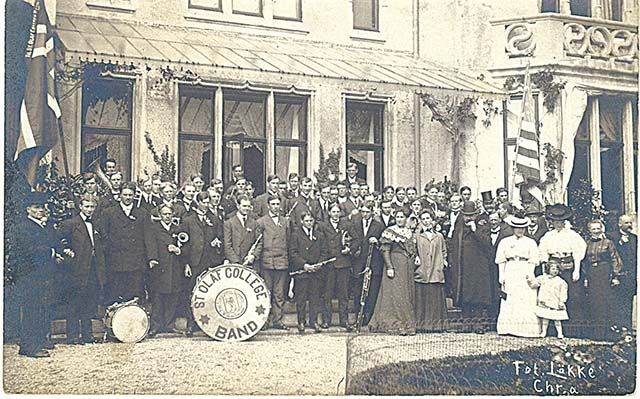
To conclude his first year, Christiansen arranged to hold his first Music Festival at Northfield’s Ware Auditorium (now the Grand Event Center). The band had a successful evening concert on May 17, preceded by an afternoon baseball game won by Luther College. On May 18, choirs from Duluth, Eau Claire and Decorah joined St. Olaf’s Choral Union and the Danz Symphony Orchestra of Minneapolis (forerunner of the Minnesota Orchestra) to present Haydn’s Oratorio The Creation. On May 21, the ecstatic headline of the Northfield News extolled Christiansen’s “Untiring Efforts and Superior Skill as a Leader in Music.”
In January of 1905, Christiansen led the band on its first tour of southern Minnesota and northern Iowa. Schmidt later described the tour as a “financial flop” during which band members had to deal with snow and cold and even chip in to buy train tickets from Faribault to the second stop to continue the tour. But Schmidt picked up valuable lessons as faculty representative and drum major on this tour and became the longtime manager of musical organizations. (Schmidt was succeeded by his son, Frederick, who teamed up with F. Melius Christiansen’s son, Olaf, the second director of the St. Olaf Choir.)
On May 27, 1905, a touring Student Singing Society from the University of Christiania in Norway came to Northfield for a concert at the Ware Auditorium. Schmidt wrote that the singers were treated to a lunch on the lawn of Ytterboe Hall before the concert and, “Two things especially seemed to interest them greatly – the heaping bowls of fresh strawberries and cream and the playing of the band.” Christiansen, a native of Norway, entranced them with his arrangements of Norwegian music. The touring group’s American manager persuaded a Minneapolis businessman, Olaf Searle of the Scandinavian American Steamship Line, to make up any deficit that might occur from a band trip to Norway in 1906.
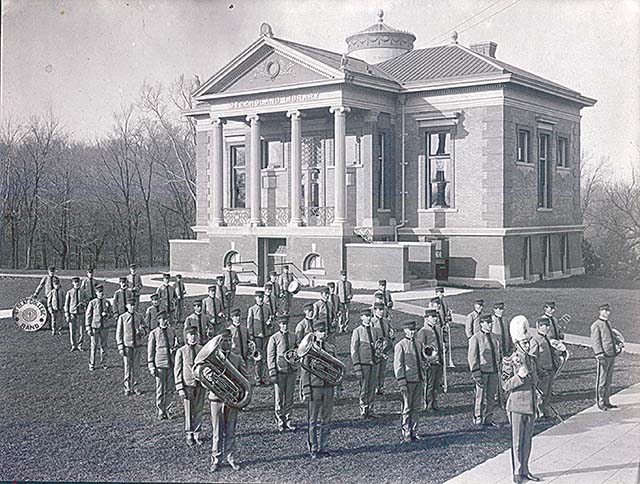
In this way, the St. Olaf Band became the first American college musical organization to conduct a concert tour abroad. Six tour stops were made by the band between Minnesota and New York, including Chicago and Brooklyn, and the steamship Oskar II left for Europe on June 20. When they reached Christiania (Oslo) on July 2, the boat was greeted with cannon booms from the Akershus Fortress and The Star Spangled Banner sung by the Student Chorus that had visited St. Olaf the year before. The band responded with the Norwegian anthem, Ya Vi Elsker.
The 46-member all-male band introduced the saxophone to Norway – and also the American pastime of baseball. On the 4th of July, a crowd came to see an exhibition by the band boys, who used a fencing mask as a catcher’s mask and a ball and bat which had been souvenirs from the Norwegian singers’ American tour. Schmidt said, “Most people in the audience thought the game too dangerous, especially catching high flies.”
The band’s repertoire included Christiansen’s own Norwegian Rhapsody, Alexander’s Olympia Hippodrome March, Donizetti’s Lucia, Elsa Entering the Cathedral from Wagner’s Lohengrin, Rossini’s William Tell and Tancredi Overtures, Schumann’s Traumerei, Macbeth’s Love in Idleness, Delibes’ Intermezzo, Grieg’s Landsighting, Teilman’s Kroningsmarsj, Sousa’s Stars and Stripes and the national anthems of the U.S. and Norway. A soprano soloist sang selections from Gounod, Sullivan, Schumann, Hawley and Martens.

The St. Olaf Band played 26 concerts between July 4 and July 27 in Norway, starting with an appearance before 6,000 at Tivoli, an open air amusement park. Police had to try to clear out of the way the crowds that had gathered to watch the band march from their hotel to the sold-out venue. At a concert at Eidsvold, home of Norway’s Independence Hall, Schmidt said that “The sudden, thunderous rolling of the drums” at the conclusion of the playing of the Norwegian national anthem so startled an official that he ended up “lying flat on the floor in a quivering faint.” At Trondheim, prior to a concert in the magnificent cathedral, the band paid its respects at the grave of the founder of St. Olaf, Rev. Bernt Julius Muus. Also, the newly crowned King Haakon asked the band to play for the royal family at their residence there.
The boat Andenaes took the band to concert dates in coastal cities for 17 days. Near Bergen, the band played for Prime Minister Christian Michelsen, who had presided over the separation of Norway from Sweden. On July 21, Christiansen returned in triumph to his boyhood home of Larvik for a concert. The newspaper, recalling him as “the little fellow” who marched with the city band, said he had now “brought glory and honor to the land of his birth.” The band left for home on July 29, with the approbation of the entire country. Schmidt estimated the total attendance figure as 61,600, not counting thousands who heard the band in open air short concerts.
Another memorable tour started on June 21, 1909, when Christiansen led the band to the west coast. The band played 100 concerts in 69 towns in 105 days, covering 5,083 miles. The trip was highlighted on Aug. 30 when the St. Olaf Band led a mile-long parade celebrating Norway Day at the Alaska-Yukon-Pacific Exposition, a world’s fair celebrating the Pacific Northwest.
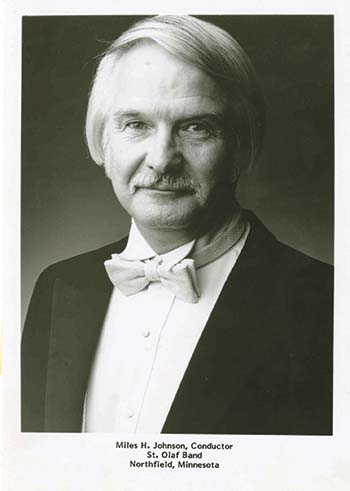
In 1919, Christiansen turned band conducting over to J. Arndt Bergh in order to devote his energies to the St. Olaf Choir, which he founded in 1912. Donald Berglund took over both the band and the orchestra in 1946 and Bruce C. Howden became band director in 1952. The longest-tenured director of the St. Olaf Band was Miles (Mity) Johnson, from 1957 to 1994, who was highly respected as a master conductor and teacher, French horn player and mentor to all who were in the band during his era, including the conductor who succeeded him, Timothy Mahr (Class of 1978). In 1966, Johnson led the St. Olaf Band on a trip to Norway, Denmark and Germany to commemorate the 60th anniversary of the 1906 St. Olaf Band tour. This tour revived overseas band tours which have continued since then.
When the St. Olaf Choir returned from its first east coast tour on May 10, 1920 (which had included a triumphant appearance at Carnegie Hall on April 27), the St. Olaf Band led a parade from the train station back to campus. F. Melius Christiansen spoke to the crowds that had gathered at Hoyme Chapel to welcome them back. He said, “The choir and band are a natural outgrowth of the culture here. They have grown naturally from a little seed way back in history and, like flowers in the woods, grew under favorable conditions. That we were successful was only that the flavor of St. Olaf was given to the world and they seemed to like it.”
And this month the 2016 St. Olaf Band will be bringing the flavor of St. Olaf to Carnegie Hall. Fram, fram!
Susan Hvistendahl played alto clarinet in the 1966 European tour under conductor Mity Johnson. A detailed account of that tour and highlights of Johnson’s life can be found in Hvistendahl’s Historic Happenings at St. Olaf College, along with stories about band members Irene Gubrud, Ronald Sell, Sharon Moe and the band days of F. Melius Christiansen. This book, and two others about happenings in Northfield and at Carleton College, can be found at the Northfield Historical Society and By All Means Graphics, the St. Olaf Bookstore and northfieldhistory.org.
Timothy Mahr Strikes Up the Band at Carnegie Hall
There’s an old joke about the absent-minded maestro racing to get to a rehearsal in New York City who is stopped by a stranger who asks him how to get to Carnegie Hall. The maestro answers breathlessly, “Practice!”
The St. Olaf College Band, conducted by Timothy Mahr, gave a concert at New York’s famed Carnegie Hall on Feb. 6, 2016 and a home concert at Skoglund Auditorium on Feb. 13. Courtesy St. Olaf College
Indeed, the St. Olaf College Band’s 95 members did just that in preparation for the band’s debut at Carnegie Hall and for the whole 2016 Winter Tour. The tour started at Owatonna High School on Jan. 23 with stops in Wisconsin, Illinois, Ohio, Virginia, Pennsylvania and New Jersey prior to Carnegie Hall, followed by a home concert at Skoglund Auditorium.
Mahr (St. Olaf Class of 1978) grew up in LaCrosse, Wisconsin, and tagged along with high school classmates on a visit during the college’s centennial celebration in 1974. After hearing a concert of the band, orchestra and choir, Mahr (who intended to major in music) knew St. Olaf was the place for him. After a year playing trombone in the Norseman Band and having opportunities to conduct it, Mahr got into the St. Olaf Band. Mahr relates memories of a Northern tier tour and a “fantastic” Interim spent with the band in London his junior year. But one of his favorite memories is when the band was playing Tchaikovsky’s 1812 Overture on tour, firing a real cannon. (“We set off fire alarms in Harlan, Iowa,” Mahr recalled.) Stephen Bergen, the percussionist in charge of the cannon, started using more and more gunpowder every night of the tour (going from one-eighth of an ounce to an ounce), culminating in a mighty blast which almost blew them off the stage at the home concert. Mahr told me, “Only Mity Johnson would take a real cannon and shoot it off indoors.”
Mahr, who has Master’s and Doctor of Musical Arts degrees from the University of Iowa, taught instrumental music at Milaca High School for three years and was director of bands at the University of Minnesota, Duluth, for ten years before succeeding Johnson in 1994. Mahr said that the band organization was “a really well-oiled, well-run machine when I took over.” Mahr keeps Johnson’s spirit alive by attention to the “tonal quality of the sound that we’re creating” and by handling himself on the podium as Johnson did. When Mahr observes his own students conducting, he said he can sometimes see “my move that I stole from Mity.” Mahr also maintains Johnson’s legacy as conductor of the Twin Cities-based Minnesota Symphonic Winds which Johnson formed in 1979. Mahr’s warm, personal relationship with the band members also reflects Johnson’s influence. Mahr told me, “We’d better be having fun or it’s just not worth it. It’s got to be a good time.”
Mahr’s musical credits are extensive. He has guest conducted more than 30 intercollegiate and all-state bands and has composed more than 75 works which have been played all over the globe. Mahr received the prestigious American Band Association/Ostwald award in 1991 for his piece, The Soaring Hawk. The prize included an ABA commission to write Endurance, which was premiered by a 125-member interservice military honor band in Washington, D.C. This tone poem, included in the 2016 tour, was inspired by the harrowing ordeal of Ernest Shackleton’s Antarctic expedition after his ship Endurance became frozen in an ice floe in 1915.
In addition to domestic tours (including a stop at Lincoln Center’s Alice Tully Hall in 2003), the band under Mahr’s baton has toured Norway twice, the British Isles, Mexico, Japan and “ate their way” from Spain through France to Italy, exploring the history of Mediterranean in 2014. Mahr has been particularly proud of the performances of the St. Olaf Band at national conferences, including the American Bandmasters Association, the Music Educators National Conference and College Band Directors National Association Convention.
Referencing the Feb. 6 Carnegie Hall appearance, Mahr said, “This is the premiere destination for any performing ensemble and it seemed appropriate for the St. Olaf Band to culminate their 125th anniversary tour in that place.” David Maslanka, “the major symphonist in the band world,” was commissioned to write a special composition, Angel of Mercy, for the St. Olaf Band to premiere at Carnegie Hall and was with the band at Carnegie Hall. Mahr was impressed with the work the band put in and the amount of alumni and parental support.
On May 5, 1891, Tchaikovsky was the conductor of the Opening Night of Andrew Carnegie’s new music hall in New York. About five months later, in the fall of 1891, 14 St. Olaf College boys started practicing four times a week as the St. Olaf College Cornet Band. Now, a century and a quarter later, as preparations were being made to take the stage of one of the most prestigious music venues in the world, Mahr told me, “I’m honored to be here. I think having the job conductor of the St. Olaf Band is a great reward; this is a plum, a coveted position.”


